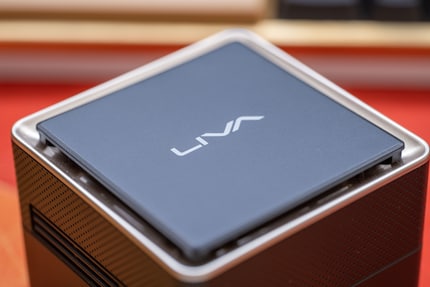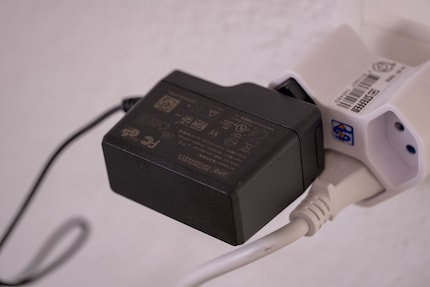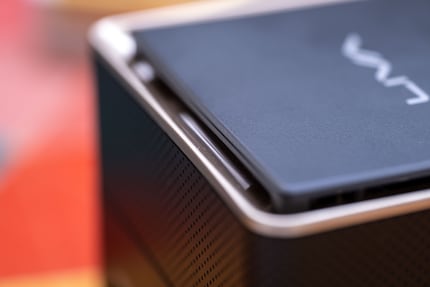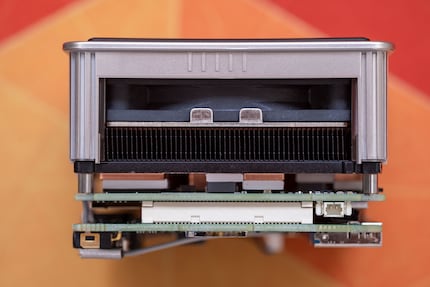

Testing a Mini PC: ECS Liva Q3 Plus
The computer mouse-sized mini PC LIVA Q3 Plus from ECS only gels with less demanding jobs.
ECS relies on a four-year-old system-on-a-chip (SoC) with the AMD Ryzen Embedded V1605B on board too. This isn’t fast by today’s standards. Its SoC isn’t the only thing that slows down the mini-PC: instead of an SSD, the Taiwanese manufacturer installed a so-called Embedded Multimedia Card (eMMC). Simply put, they’re slower and cheaper than an SSD.

What’s in the Q3 Plus
The Ryzen Embedded V1605B is an embedded variant of the mobile Ryzen 5 2500U processor. Embedded SoCs are mainly used in professional environments – in industrial sectors, for example. They’re characterised by increased reliability, an extended temperature range, long availability and robustness. In the case of the installed SoC, it will be available from 2018 to 2028.

The SoC has four cores and eight threads. Its base clock theoretically has a frequency of 2.0 GHz, with a boosted rate up to 3.6 GHz. Theoretically, as Thermal Design Power (TDP) is configurable between 12 and 25 watts. The less power is fed to the SoC, the slower it is. ECS specifies a TDP of 15 watts, which is why the SoC clocks lower than its maximum value. The L3 cache can store 4 MB. Furthermore, a Radeon RX Vega 8 GPU with 8 CUs (512 shaders) is integrated. An integrated memory controller supports a maximum of dual-channel DDR4-2400s.
The same RAM is installed in my test sample. In total there’s 8 GB of memory with the timings 17-17-17-39.
Kingston’s 128 GB eMMC is installed for mass storage. Its controller that makes it bootable. However, the controller isn’t as sophisticated as that of an SSD. In terms of speed, the eMMC is comparable to an SD card. The memory can be expanded by up to one terabyte. A slot for it is located on the right-hand side.

Two 3.2 Gen 1 and one 2.0 USB-A ports are available at the front. You can connect the Q3 Plus to the Internet either via its Gigabit LAN port or wirelessly using the 802.11ac standard – i.e. Wi-Fi 5. Bluetooth version 4.2 is included. You can connect the mini-PC to a monitor via HDMI 2.0 or Mini DisplayPort 1.4.
Since the Q3 Plus isn’t much bigger than a standard computer mouse at 74 × 74 × 52 millimetres, there’s little room for a power supply inside. The external power adapter is about the same size as a smartphone charging adapter.

The scope of delivery includes a VESA mount. Use it to attach the Q3 Plus to the back of your monitor. The mount supports 75 and 100 millimetre sizes.
Volume, temperature and power consumption
When idling, the Q3 Plus is pleasantly quiet with 37.5 dB measured from 30 centimetres. I hardly noticed it. However, the fan is audible when running the AIDA64 system stability test and pushing the Q3 Plus to its limits: I measured 46.5 dB from a distance of 30 centimetres. Fans this loud usually annoy me enormously. However, the mini-PC isn’t as extreme. That’s because the noise is rather low-frequency and therefore doesn’t get on my nerves as much.

With the AIDA64 system stability test, I also measured temperature and power consumption. The test pushes all components to their performance limits. I let it run for 20 minutes. The SoC hit a maximum of 70 degrees Celsius. Clock frequencies on all cores surrounded a constant 1.7 GHz during my test. In terms of power consumption, I measured 12 watts for the SoC. On the one hand, the system doesn’t reach the boosted rate of 3.6 GHz due to the fact that this specification only applies to one core. On the other hand, it’s due to the low power consumption as already mentioned above.
A single core benchmark from Cinebench R20 shows that even one core doesn’t reach 3.6 GHz, but a maximum of 2.0 GHz. By the way, the system draws an average of 3 watts of power when idle and hits 41 degrees Celsius.

Benchmarks
I measured the SoC’s power using various benchmarks. First up was Cinebench R20. This tests how a CPU performs when rendering 3D models. The Ryzen Embedded V1605B achieves a single core score of 197 and a multi-core score of 891. Compared to the recently tested NUC 11 Pro, that’s almost three times slower in single core and not even half as fast in multi-core. If I add the result of the Intel Core i5-10210U from CPU-Monkey, which runs in the comparably priced Intel Frost Canyon, it doesn’t look good for the Q3 Plus either. The Intel CPU is clearly ahead of the V1605B with 426 and 1797 points.
Let’s continue with 7-zip’s integrated benchmark. It tests a system for compressing and decompressing data. From this, it calculates a score in Giga-Instructions per second (GIPS). I chose the default «dictionary size» of 32 megabytes. The V1605B reaches 16 743 GIPS. That’s about half as much as the Intel Core i7-1185G7 in the NUC 11 Pro, which reaches 32 878 GIPS. Still, the Ryzen SoC is more or less on par with the i5-10210U here – which achieves 16 742 points.
In version 3.0 and above, the Blender benchmark renders three scenes and tallies up three scores from them. I’ve added these up to give end scores for each. With 33.52 points, the V1605B is again far behind the i7-1185G7, which achieves 66.08 points. The Ryzen SoC is more or less on par with the Intel Core i5-10210U and its 35 points in this benchmark.
Finally, I ran the PCMark 10 benchmark. It tests diverse scenarios such as app loading times, the efficiency of spreadsheet calculations, web browsing and photo and video editing. In other words, it demonstrates how suited a processor is to everyday work. From that, it calculates a score. With 2579 to 4490 points in the i5-10210U, the difference is again substantial here.
To test the performance of the Radeon RX Vega 8 GPU, I ran the Night Raid benchmark. It tests the performance of integrated GPUs. With 5612, the Vega is around 650 points better than an Intel UHD Graphics 620 in the i5-10210U.

Mass storage and memory
I tested the installed Kingston eMMC mass storage with the ATTO Disk Benchmark and PCMark8.
The ATTO Disk Benchmark uses uncompressed data. It tests read and write performance of various transfer sizes from 512 B to 64 MB in sequential read and write. Sequentially stored data is saved in contiguous blocks. Thanks to sequential read and write, you can estimate how fast the SSD is when accessing large multimedia files, transcoding videos or watching movies.
With a maximum of 318 MB/s read and 257 MB/s write, the eMMC is much slower than SSDs – even external ones. For example, the Crucial X6, an external SSD, offers a maximum of 874 and 818 MB/s, respectively. An external HDD, which is slower because it has to retrieve data mechanically, is about half as fast as the installed eMMC when reading and writing.
PCMark 8’s storage benchmark is based on an actual scenario. The PCMark 8 storage test simulates tasks that result from different usage of the Adobe Creative Suite, Microsoft Office and games. It records memory activity and generates a benchmark score based on the saved hard drive.
Here,the eMMC isn’t much slower than an SSD in real-life scenarios. At 4565, it’s just over 500 points behind new SSDs, which use the NVMe interface and PCIe 4.0. Nevertheless, I get the impression that programs take longer to open.
The installed 8 GB of RAM are rather tight. Personally, I always recommend at least 16 GB. With Windows 11, almost 50 per cent of the memory is already occupied without me having programs open in the foreground.

Verdict: slow, but still worth a look depending on the use
Purely according to benchmarks, the Q3 Plus is only suited to simple jobs – office work, for example. However, due to its size and the embedded SoC, it’s also suitable for certain industrial applications where little computing power is required.
It could also work in a home office, since it can be easily attached to the back of a monitor with the included VESA mount. The performance is perfectly sufficient for office work and browsing, the mini-PC usually runs very quietly.
Its mass storage and RAM are tight. I’d have liked to see more here. Especially in terms of mass storage, as ECS relies on inexpensive eMMC memory.
At around 440 francs/euros (as of: 5. May 2022), the Q3 Plus is well positioned in terms of price. I can recommend it to anyone who wants and needs little power in a small system.
From big data to big brother, Cyborgs to Sci-Fi. All aspects of technology and society fascinate me.


